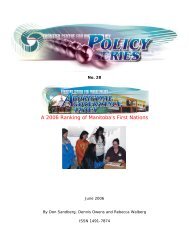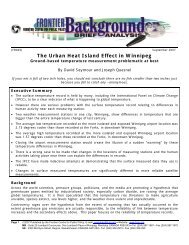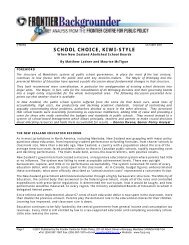The New Paradigm - Federal Reserve Bank of Dallas
Create successful ePaper yourself
Turn your PDF publications into a flip-book with our unique Google optimized e-Paper software.
20<br />
Exhibit 14<br />
Declining Long-Run Average Cost:<br />
<strong>The</strong> Supply-Side Revolution<br />
It takes roughly $350 million<br />
to bring the average new<br />
drug to market. That’s just for<br />
the first pill. Making the second<br />
costs closer to a penny.<br />
Clearly, nobody’s going to pay<br />
$350 million for that first pill.<br />
So to make medicine affordable,<br />
drug companies have to<br />
spread the cost <strong>of</strong> developing<br />
their products over years and<br />
years <strong>of</strong> sales. <strong>The</strong> larger the<br />
sales, the less each unit can<br />
cost the consumer. Assuming<br />
$350 million in development<br />
costs and 1¢ marginal production<br />
cost thereafter, the average<br />
cost <strong>of</strong> making a pill would<br />
fall from $350 million for producing<br />
just one to $350.01<br />
each for making a million to 4¢<br />
each for sales <strong>of</strong> 10 billion.<br />
Prices fall in inverse proportion<br />
to the size <strong>of</strong> the market. This<br />
example illustrates that for<br />
pharmaceuticals demand is<br />
not the enemy <strong>of</strong> price but its<br />
friend. <strong>The</strong> higher the demand,<br />
the lower the price because,<br />
after all, you can’t have quantity<br />
discounts without quantity.<br />
Many products in today’s<br />
economy are produced under<br />
exactly this type <strong>of</strong> condition—<br />
high fixed and low marginal<br />
cost—and thus enjoy long-run<br />
average cost curves that slope<br />
downward. S<strong>of</strong>tware, CDs,<br />
tapes, movies and even many<br />
sophisticated electronic products<br />
are in this category.<br />
Economies <strong>of</strong> scale also tend<br />
Average Cost <strong>of</strong> a Pill<br />
Cost<br />
1 . . . . . $350,000,000.00<br />
10 . . . . . . 35,000,000.01<br />
100 . . . . . . 3,500,000.01<br />
1,000 . . . . . . 350,000.01<br />
10,000 . . . . . . 35,000.01<br />
100,000 . . . . . . 3,500.01<br />
1,000,000 . . . . . . 350.01<br />
10,000,000 . . . . . . 35.01<br />
100,000,000 . . . . . . 3.51<br />
1,000,000,000 . . . . . . .36<br />
10,000,000,000 . . . . .04<br />
Quantity<br />
to dominate industries that<br />
deliver their goods or services<br />
through a network—such as<br />
telephone, television, radio,<br />
facsimile, e-mail, Internet and<br />
other communication or news<br />
services; passenger and freight<br />
air travel, railroad traffic, trucking,<br />
package delivery, pipelines<br />
and other transportation services;<br />
and electricity, gas, water,<br />
sewer, garbage and other public<br />
utilities.<br />
Even parts <strong>of</strong> the wholesale<br />
and retail distribution network<br />
can enjoy substantial<br />
economies <strong>of</strong> scale. <strong>The</strong> same<br />
can apply to services that are<br />
highly knowledge-intensive,<br />
such as education, legal and<br />
medical services, because<br />
knowledge is nonrivalrous.<br />
<strong>The</strong> cost <strong>of</strong> developing the<br />
infrastructure to train just one<br />
doctor is huge, but once it’s<br />
set up, training the second<br />
costs much less.<br />
For all these industries and<br />
others, the larger the market,<br />
the less each unit can cost.<br />
a. Wireless Rates in <strong>Dallas</strong>, March 1999<br />
Average cost per minute<br />
$.60<br />
b. Internet Access Cost and Host Density, 1998<br />
Access cost (Index, OECD=100)<br />
200<br />
$.50<br />
180<br />
160<br />
Czech Republic<br />
•<br />
•Austria<br />
•Belgium<br />
$.40<br />
$.30<br />
$.20<br />
140<br />
120<br />
100<br />
80<br />
60<br />
Ireland<br />
•<br />
France<br />
Luxembourg<br />
• • United Kingdom<br />
• •<br />
Germany •Switzerland<br />
• Hungary •Netherlands<br />
• Portugal OECD<br />
Greece •<br />
•Denmark<br />
Mexico• •<br />
Japan<br />
•Poland<br />
• Korea • Sweden<br />
•<br />
• Turkey<br />
<strong>New</strong> Zealand<br />
Italy•<br />
•Spain<br />
• United States<br />
•Australia<br />
•<br />
Canada<br />
•Norway<br />
•Iceland<br />
•Finland<br />
$.10<br />
40<br />
20<br />
$0<br />
60 100 250 500 1,000<br />
Subscribed minutes<br />
0<br />
0 20 40 60 80 100 120<br />
Internet hosts per 1,000 people<br />
1999 ANNUAL REPORT <strong>Federal</strong> <strong>Reserve</strong> <strong>Bank</strong> <strong>of</strong> <strong>Dallas</strong>

















